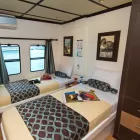- Ship
- 1 Breakfast, 1 Lunch, 1 Dinner
This morning stop at Pitt Point, one of the only two sites where all of the three types of boobies breed, and it is also the site where great frigate birds and swallow-tailed gulls are seen. Two wind sculptured tuff cones at Pitt Point make up the extreme eastern end of San Cristobal, and thus, the archipelago as well. These cliffs were the first sight of land when HMS Beagle and Charles Darwin arrived on September 15, 1835. On the small green sand beach, be welcomed by a group of barking Galapagos sea lions. This is a bachelor colony, where males usually relax and prepare themselves for fighting and mating.
From saltbush and spiny shrubs behind the beach, a trail leads up to an area of tropical dry forest vegetation: most of the year leafless palo santo trees, yellow cordia shrubs, tiny prickly pear cacti, and carpetweed that turns red in the dry season. After the pretty steep climb through a gully to the clifftop, you can wander around the only colony in Galapagos that counts with all three species of boobies: blue-footed, red-footed, and Nazca booby; as well as both species of frigate bird (great and magnificent), famous because of their scarlet balloon-sized pouches during mating season. Frigate birds would rather attack returning boobies and conduct aerial battles than fishing for themselves.
Afterward, visit Witch Hill, one of the first sites visited by Charles Darwin. The primary attraction of this site is the coral sand beach, an excellent place to swim and snorkel. Witch Hill is the remains of a tuff cone and one of the first sites visited by Charles Darwin. It has an impressive landscape, where it is often possible to see coastal and migratory birds, including pelicans, blue-footed boobies and swallow-tailed gulls, as well as sea lions and marine iguanas. At times, the lagoon is completely dry, and deposits of salt may be found in the bottom. The people of Puerto Baquerizo Moreno used to use the lagoon as a salt mine.


















